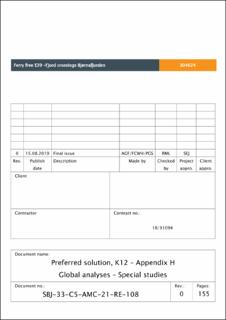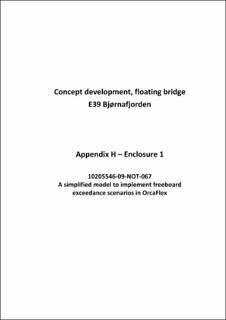| dc.contributor.author | Statens vegvesen | |
| dc.contributor.author | AGF/FCWH/PGS | |
| dc.coverage.spatial | Norway, E39 Bjørnafjorden | en_US |
| dc.date.accessioned | 2020-06-30T07:44:56Z | |
| dc.date.available | 2020-06-30T07:44:56Z | |
| dc.date.issued | 2019-08-15 | |
| dc.identifier.uri | https://hdl.handle.net/11250/2659965 | |
| dc.description.abstract | This report describes the work performed in consideration of special studies in the concept development work of a floating bridge over Bjørnafjorden. Considered effects are hydrodynamic effects such as viscous damping, wave-current interaction, hydrodynamic interaction effects and freeboard exceedance.
Preliminary global analysis with wave-current interaction shows large influence on almost all response variables, partly due to a doppler-shift of the wave excitation frequency and partly due to an additional change in the radiation solution and wave excitation loads due to wave-current interaction. With a current in opposite direction of the waves, the encounter frequencies for the waves on the pontoons are decreased and different eigenmodes are excited. With a current velocity of 1.5 m/s combined with the 100-year easterly wind wave, the resulting motion is significantly increased compared to the zero-current case. Especially the strong axis moment is influenced. The realism of the studied case with an extreme current opposing the extreme wind wave is questionable as extreme currents are believed to be wind-driven. Met-ocean data must be updated in order to find a realistic combination of opposing current and wind waves before the effect on the load effects for the selected concept can be determined.
The hydrodynamic interaction between pontoons has an influence on the response. The effect is found to be largest for the vertical motion and the weak axis moment. Further, the hydrodynamic interaction effect is larger for shorter span widths. This is checked in the global analysis by comparing 100 m span width and 125 m span width, with and without hydrodynamic interaction. The effect may be important for typical fatigue sea states, especially for 100 m pontoon spacings.
The effect of computing full quadratic transfer functions (QTF) in WAMIT for the slowly varying drift loads on a pontoon has been compared with the Newman approximation. The comparison shows that the Newman approximation is conservative for the most relevant wave periods.
A simplified analysis has been performed with an inhomogeneous wave field. A fully uncorrelated wave field between the pontoons have been simulated by changing the phase angle of the wave excitation load coefficients for every pontoon. More analysis is needed, but the preliminary results show that it potentially can give a slight increase in the response. Studies with varying wave height across the fjord have been completed, where the results show some local effects towards the abutments.
A methodology to assess the effect of freeboard exceedance has been developed. The methodology is checked for both a single pontoon and on the global bridge system. The first analysis on the global bridge system in 100-year wind wave event resulted in negligible change in response compared to the equivalent simulation without the methodology.
The effects studied in this report have been considered in terms of their global consequence. They were not explicitly accounted for in the global analysis run in Appendix G, but considered as a requirement to robustness of the design that has affected the design development throughout the project. | en_US |
| dc.description.sponsorship | Statens vegvesen | en_US |
| dc.language.iso | eng | en_US |
| dc.publisher | Statens vegvesen | en_US |
| dc.relation.ispartofseries | Statens vegvesens rapporter; | |
| dc.rights | Attribution-NoDerivatives 4.0 Internasjonal | * |
| dc.rights.uri | http://creativecommons.org/licenses/by-nd/4.0/deed.no | * |
| dc.subject | Statens vegvesen | en_US |
| dc.subject | SBJ-33-C5-AMC-21-RE-108 | en_US |
| dc.subject | E39 Bjørnafjorden | en_US |
| dc.title | Preferred solution, K12 – Appendix H Global analyses – Special studies | en_US |
| dc.type | Report | en_US |
| dc.source.pagenumber | 155 | en_US |


